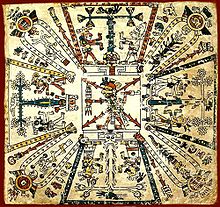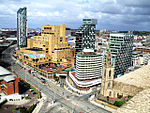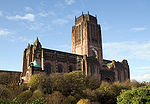- World Museum
-
- "World Museum Liverpool" and "Liverpool Museum" redirect here. For the similarly named museum, see Museum of Liverpool.
Coordinates: 53°24′36″N 2°58′53″W / 53.409992°N 2.981323°W
World Museum Established 1851 (as Derby Museum) Location William Brown Street, Liverpool, England, United Kingdom Visitor figures 605,601 (2009)[1]
Director David Fleming OBE Website http://www.liverpoolmuseums.org.uk/wml/ World Museum is a large museum in Liverpool, England which has extensive collections covering archaeology, ethnology and the natural and physical sciences. Special attractions include the Natural History Centre and a free Planetarium. Entry to the museum itself is also free. The museum is part of National Museums Liverpool.
The museum has recently undergone extensive refurbishment in order to double the size of the display spaces, making even more of the collections accessible for visitors. Major new galleries include World Cultures, the Bug House and the Weston Discovery Centre. A central entrance hall and six-storey atrium opened in 2005. On reopening after this refurbishment and extension the museum's name changed from its previous title of Liverpool Museum, which it had held since its establishment at its current William Brown Street site in 1860.
Contents
History
Establishment and development
The museum was originally started as the Derby Museum as it comprised the Earl of Derby's natural history collection. The museum opened originally in 1851, sharing two rooms on Duke Street with a library. However, the museum proved extremely popular and a new, purpose-built building was required.
Land for the new building on a street then known as Shaw's Brow opposite St. George's Hall was donated by local MP and Merchant William Brown, as was much of the funding for the building which would be known as the William Brown Library and Museum. Around 400,000 people attended the opening of the new building in 1860.
In the late 19th century, the museum's collection was beginning to outgrow its building so a competition was launched to design a combined extension to the museum and college of technology. The competition was won by William Mountford and the College of Technology and Museum Extension opened in 1901.
Liverpool, being one of the UK's major ports, was heavily damaged by German bombing during the blitz. While much of the Museum's collection was moved to less vulnerable locations during the war, the museum building itself was struck by German firebombs and suffered heavy damage. Parts of the museum only began to reopen fifteen years later.
In the early first decade of the 21st century, the museum was again expanded, taking over the lower half of the extension which was then owned by Liverpool John Moores University. To better reflect its larger size, the museum was renamed World Museum Liverpool.
Deaths
The museum has been the site of three deaths since its 2005 reopening. On the 15 May 2006, a 24 year old man climbed over a balcony on the sixth floor and jumped to his death. On the 26 November 2006, a 17 year old mother was stabbed to death by her 21 year old former male partner, who then jumped to his death from a third floor balcony. The coroner has since recorded verdicts of unlawful killing and suicide.[2]
Exhibits
Astronomy, Space and Time
 The Black Knight BK02 is located in the Space & Time wing of the museum
The Black Knight BK02 is located in the Space & Time wing of the museum
The physical sciences collection of World Museum was built after the devastation caused by the incendiary fire of 1941. The collection has expanded, in part, due to transfers from the Decorative Arts Department, Regional History Department, Walker Art Gallery and the Prescot Museum. The collection also contains several significant collections from the Liverpool Royal Institution, Bidston Observatory, later the Proudman Institute of Oceanographic Sciences, and the Physics Department of the University of Liverpool.
Collections such as these are often made up of items of a singular type designed for a particular experiment such as DELPHI or LEP at CERN - the European Organisation for Nuclear Research, or the Equatorium, a post-Copernican planetary calculator made to special order in the early 17th century. As a consequence the collection is small but contains a number of significant items.
The planetarium opened in 1970 and has 62 seats. It currently attracts about 90,000 people per year. Shows cover various aspects of space science, including the Solar System, space exploration and has special children's shows. Entrance to the planetarium is free.
Planetarium
World Museum is home to a planetarium.
Human History
 The Codex Fejérváry-Mayer which is located in the museum is an Aztec Codex and one of the few manuscripts to have survived the Spanish conquest of Mexico
The Codex Fejérváry-Mayer which is located in the museum is an Aztec Codex and one of the few manuscripts to have survived the Spanish conquest of Mexico
 Funerary statue of Ama'alay dhu-Dharah'il from Hayd ibn Aqil (ancient Saudi Arabia)
Funerary statue of Ama'alay dhu-Dharah'il from Hayd ibn Aqil (ancient Saudi Arabia)
Archaeology and Egyptology
The Egyptology collection contains approximately 15,000 objects from Egypt and Sudan and is the most important single component of the Antiquities department's collections. The chronological range of the collection spans from the Prehistoric to the Islamic Period with the largest archaeological site collections being Abydos, Amarna, Beni Hasan, Esna and Meroe.
Over 5000 Egyptian antiquities were donated to the museum in 1867 by Joseph Mayer(1803–1886), a local goldsmith and antiquarian. Mayer purchased collections from Joseph Sams of Darlington (which contained material from the Henry Salt sale in 1835), Lord Valentia, Bram Hertz and the Reverend Henry Stobart. Mayer had displayed his collection in his own ‘Egyptian Museum’ in Liverpool with a purpose of giving citizens who were unable to visit the British Museum in London some idea of the achievements of the Egyptian civilization. On the strength of this substantial donation other people began to donate Egyptian material to the museum, and by the later years of the 19th century the museum had a substantial collection that Amelia Edwards described as being the most important collection of Egyptian antiquities in England next to the contents of the British Museum.
The quality of the Mayer donation is high and there are some outstanding items, but with a few exceptions the entire collection is unprovenanced. The collection was systematically enhanced through subscription to excavations in Egypt. Altogether the museum subscribed to 25 excavations carried out by the Egypt Exploration Fund (now Egypt Exploration Society), the British School of Archaeology in Egypt, and the Egyptian Research Account between 1884 and 1914. It was further developed through links with the Institute of Archaeology at Liverpool University and important collections came to the museum from the excavations of John Garstang who was honorary reader in Egyptian archaeology at Liverpool University 1902–07, and Professor of Methods and Practice of Archaeology 1907–41. The museum has always had a close relationship with the university; in the early 1920s Percy Newberry, Brunner Professor of Egyptology, and his successor T. Eric Peet, catalogued the collection, assisted with the rearrangement of the displays, and produced a handbook and guide to the Egyptian collection (1st ed., 1923).
In May 1941, at the height of the Liverpool Blitz, a bomb fell on the museum, which was burnt to a shell. Large parts of the collection had been removed at the outbreak of the war, but much remained on display or in store and many artefacts were destroyed. What remained was quite inaccessible and it was not until 1976 that a permanent Egypt gallery was opened in the rebuilt museum. Following the war the museum actively augmented the collection through collecting of new material from excavations in Egypt and Sudan and the purchase of other museum collections. In 1947 and 1949 the material from Garstang’s excavations at Meroe came to the museum, and in 1955 Liverpool University placed substantial amounts from its own collections within the museum, including many items from Beni Hasan and Abydos. In 1956 the museum purchased almost the entire non-British collections of the Norwich Castle Museum. This included EES excavated material from Amarna and other sites, botanical remains from Kahun and the private collection of Sir Henry Rider-Haggard. In 1973 the collection was increased further by the acquisition of part of the Sir Henry Wellcome Collection, and by the bequest of Colonel J. R. Danson in 1976, which included more material from Amarna and from Garstang’s excavations at Abydos.
A handy lavishly illustrated guide to the collection is available: ‘Gifts of the Nile’ (London: HMSO, 1995).
Following a successful application to the Museums & Galleries Improvement Fund [1] of the DCMS and the Wolfson Foundation the museum will be opening a new Egypt gallery in August 2008. The project with a total budget of £600,000 aims to build on the success of the hugely popular World Museum by revitalising the Egyptian gallery, which is now 30 years old.
Ethnology
The ethnology collection at World Museum ranks among the top six collections in the country. The four main areas represented are: Africa, the Americas, Oceania and Asia. The exhibition includes interactive displays.
Natural History
Biology and Zoology
In the Natural World area can be seen a range of exhibits, including live colonies of insects and historic zoological and botanical exhibits.
The 13th Earl of Derby founded the original museum with a major donation of zoological specimens in 1851, including many rare and 'type' specimens, the ones that act as standards for the species. There also specimens of several extinct species housed in the museum, including the Liverpool Pigeon, the Great Auk (and an egg), the Falkland Islands Wolf, the South Island Piopio, the Lord Howe Swamphen, the Dodo, the Long-tailed Hopping Mouse, and the Thylacine. Another attraction in the Natural world area is an art gallery with pictures of natural artist Edward Lear.
The museum’s collections have grown considerably since then and now also include important botanical specimens dating back over 200 years, which represent most of Britain and Ireland’s native flora. Visitors can examine the collections up close in the award winning Clore Natural History Centre, where there are interactive displays.
Geology
The geological collection at World Museum contains over 40,000 fossils as well as extensive rock and mineral collections. Each of these exhibits show information about the origins, structure and history of the planet Earth.
Founded in 1858, only seven years after the museum's establishment, much of the original collection was destroyed during the Second World War. The post-war collections have expanded considerably, thanks in part to the acquisition of several significant museum and university collections.
The largest of these was the University of Liverpool's geological collection that includes some 6,600 fossil specimens. The collection covers the following areas: palaeontology, rocks and minerals.
Notes and references
- ^ "VISITS MADE IN 2009 TO VISITOR ATTRACTIONS IN MEMBERSHIP WITH ALVA". Association of Leading Visitor Attractions. http://www.alva.org.uk/visitor_statistics/. Retrieved 21 May 2010.
- ^ "Stabbed mother 'cried for help'", BBC, 25 January 2007. Retrieved 3 August 2007.
External links
National Museums Liverpool International Slavery Museum · Lady Lever Art Gallery · Merseyside Maritime Museum · Museum of Liverpool · Seized! The Border and Customs uncovered · Sudley House · Walker Art Gallery · World Museum
Closed: National Conservation Centre (closed 2010) · Museum of Liverpool Life (closed 2006)Categories:- 1853 establishments in England
- National Museums Liverpool
- Archaeology museums in England
- Natural history museums in the United Kingdom
- Planetaria
- Museums in Liverpool
- Collection of the World Museum Liverpool
- Egyptological collections in England
- Museums of Ancient Rome in the United Kingdom
- Museums of Ancient Greece
- Numismatic museums in the United Kingdom
- Geology museums in the United Kingdom
- Dinosaur museums
- Insectariums
- Science museums in the United Kingdom
- Museums established in 1853
Wikimedia Foundation. 2010.






